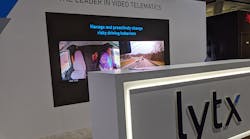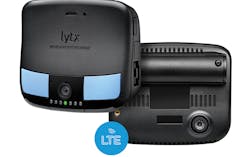This is the fourth part of a five-part feature on how cameras and video are changing fleets and drivers as a new decade dawns. Read Part 1, Part 2 and Part 3.
Lytx was recently named “2019 Company of the Year” by Frost & Sullivan for video safety solutions in North America.
The consulting and research firm said that through computer vision and artificial intelligence, Lytx’s clients experienced a 39% reduction in drowsy driving and 66% reduction in falling asleep behind the wheel.
Based on data from June 2018-June 2019, Lytx’s solutions also reduced claims costs by up to 80% and collision frequency by up to 50%.
Lytx’s technology captures real-time video and sensor data about the vehicle, driver, road and driving conditions. It analyzes all of this information to create a more complete picture of risk and safety. That bigger picture also helps fleets create better driving practices.
“With the scale of its data — more than 100 billion miles of driving data and 100,000 risky driving events captured by video every day — Lytx has the largest video-based database in the industry,” according to Frost & Sullivan, “and is unmatched in its ability to provide fleets with the knowledge needed to help protect drivers and improve their driving behavior.”
Frost & Sullivan said that Lytx maintains a dominant market share, which remains greater than all of its competitors combined.
“This is no small feat considering the intense level of competition heating up the fast-growing market for video telematics,” said Mugundhan Deenadayalan, senior research analyst at Frost & Sullivan.
Lytx machine learning uses its database of more than 60 million professionally labeled behaviors annually to identify risky driving behaviors inside the vehicle, such as cell phone usage, eating while driving, smoking, and driving without a seat belt. The company’s advanced AI technology is continuously evolving to read driver behavior and prescribe coaching workflows based on the analyzed video data.
As Frost & Sullivan points out in its study, the most advanced fleets are using AI and machine learning to analyze countless hours of video footage.
“These solutions learn from the footage to provide an accurate perspective into both the driver’s driving behavior and the vehicle’s performance,” according to the study.
“This level of knowledge empowers drivers to learn from their mistakes and adopt safer driving practices. The benefits of this valuable tool can go far beyond driver coaching and training, providing helpful in-cab driving recommendations, reliable evidence for court cases, and reduced insurance premiums.”
The advanced technologies that build sophisticated analytical models and suggestions based on video data will take road safety to the next level, Frost & Sullivan predicts.
“Lytx believes that video telematics coupled with AI-based machine learning can drive change and help achieve a future where no commercial driver is ever the cause of a collision,” the firm wrote as a reason it considers the San Diego-based fleet tech company “the forerunner in introducing in-vehicle cameras, machine vision, and AI-based video telematics to commercial vehicle fleets.”
The firm specifically lauded Lytx’s Risk Detection Service and Driver Safety Program, where clients can access 100 hours of continuous, on-demand video.
Lytx’s regular reviews of customers’ fleets are another example of one of the company’s best practices, according to Frost & Sullivan. These reviews help customers identify trends within their fleets and then guide continuous, measurable improvements in terms of safety and operational efficiencies.
This is the fourth part of a five-part feature on how cameras and video are changing fleets and drivers as a new decade dawns. Read Part 1, Part 2 and Part 3.





